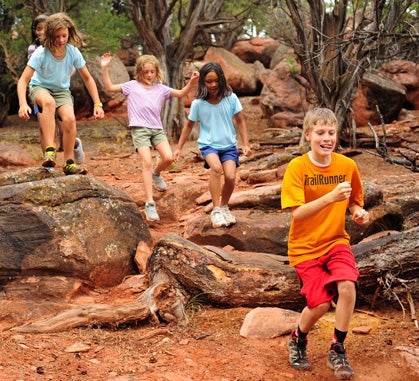Child's Play

When and how should children hit the trail?
Have you ever watched children on a playground? They run. They sprint. They go until recess is over with no complaints of being tired, sore or thirsty. Their natural state of blissful play is what the rest of us runners attempt to achieve on a daily basis.
But how do we get children to take that next step to becoming a “runner” without losing their joy for the sport? What do you do when your 11-year-old wants to join you on your daily jaunt, or how do you help a 16-year-old track-and-field athlete focused on negative splits?
Photo by Duane Raleigh
This article appeared in our November 2009 issue.
“Keep it fun,” says John Cowell, CSCS, strength coach to Olympic and World Champion athletes, former professional cyclist and father. “With children, we are laying the groundwork for activity when they are 25, 35 and beyond. If we as parents, adults and coaches make it too serious when kids are young, they will potentially turn away from exercise as they age.”
Why Trail Running?
Children’s bodies change and grow through their teens and even into their 20s. Serious participation in a singular sport at a young age can actually inhibit a child’s ability to perform other exercises, according to Cowell. Although coordination, timing and balance are fairly well developed by age 11, it is still beneficial for young bodies to experience a wide range of motion and activities to develop their muscular and skeletal systems.
By jumping over logs, hopping off rocks, running on uneven trails and going up and down hills, children boost balance and coordination, while enjoying the outdoors.
“Young people are increasingly disconnected from nature, and it’s resulting in serious health and wellness implications,” says Chris Fanning, executive director of The Outdoor Foundation. “Childhood obesity is at an all-time high, but research shows that a moderate dose of outdoor activity—trail running being a perfect example—can reverse weight gains and boost self esteem.”
Let’s Play
To get started, take kids on a hike and play. Enjoy the scenery, check out the flora and fauna, go splash in a stream. Before moving on to running, understand your child’s personality and abilities, says Amanda McIntosh, two-time winner of Colorado’s Leadville 100, private coach for runners of all ages and abilities, mother of two and a former high-school cross-country coach. It is also a good time for a self check—make sure this is what your children want to do and not just what you want them to do.
“It’s the adult’s responsibility to adapt their running to a child’s level, instead of expecting a child to run an adult’s normal 10K pace and route,” says Cowell.
This may mean more time spent splashing in mud puddles and looking at caterpillars than we are used to. When the time is right, ease your child into running with races from tree to tree, a run to the bottom of a hill or by seeing how far and fast you can go in 50 steps.
The Next Step
According to McIntosh, “Ninety percent of kids between the ages of seven and 12 are not ready for a regimented training program.” If they aren’t having fun, children will not be motivated to run.
However, as children advance into their teens, their miles can also increase. As girls enter puberty, they tend to slow down slightly as their center of gravity changes with the development of hips and breasts. It takes some time to adjust their running form and regain speed. Boys will actually see a marked improvement in strength and speed as they enter adolescence and develop muscles.
“Teaching teenagers they can achieve something they perceive as impossible at the outset” is what inspires Kate Bartlett, acting director of the High Mountain Institute in Leadville, Colorado, where she runs a semester-away program for high-school juniors. Kids come for academics, a six-week backpacking trip and a 10-mile fun run. At the start of the semester, many of the kids have never run around the block, but by the end of 16 weeks of closely supervised training, they are all able to complete the 10-mile course.
“I ask my athletes to do nothing longer than a half marathon before they graduate from high school,” says McIntosh. However, as an example of how you need to know your kids, she admits to allowing her teenage son to run a 25K.
“He asked me if he could, and I said only if I could run with him.” McIntosh kept the mood light, went at his pace and enjoyed an amazing day with her son. “He prefers ice hockey, which is fine by me, but he also knows he can run and enjoy it.”
Red Flags
The biggest hurdle with children and sports is teaching them how to hydrate and refuel properly. “Getting thirsty and taking a sip of water is not enough,” says McIntosh. As responsible adults, we must always provide water and food for our younger running partners. Adults get to be pack mules so kids can experience the freedom of unencumbered running.
Most children won’t enjoy maximum-caffeine, mocha-latte gels, so bring along kid-friendly snacks (e.g. gummies, dried fruit, chocolate, nuts) in addition to plenty of water or watered-down juice. Take breaks every 15 minutes or so, to give them the chance to rest, eat and drink. Always remember sunscreen, hats and sunglasses, and tuck a band-aid or two in your pack in case of blisters.
If a child’s motivation and interest in trail running start to wane, mix up the activities—choose a different trail, go for a swim or play some Frisbee. Let the child’s interest level be your guide.
“When introduced with joy and without pushing, trail running offers children a lifetime sport,” says McIntosh.